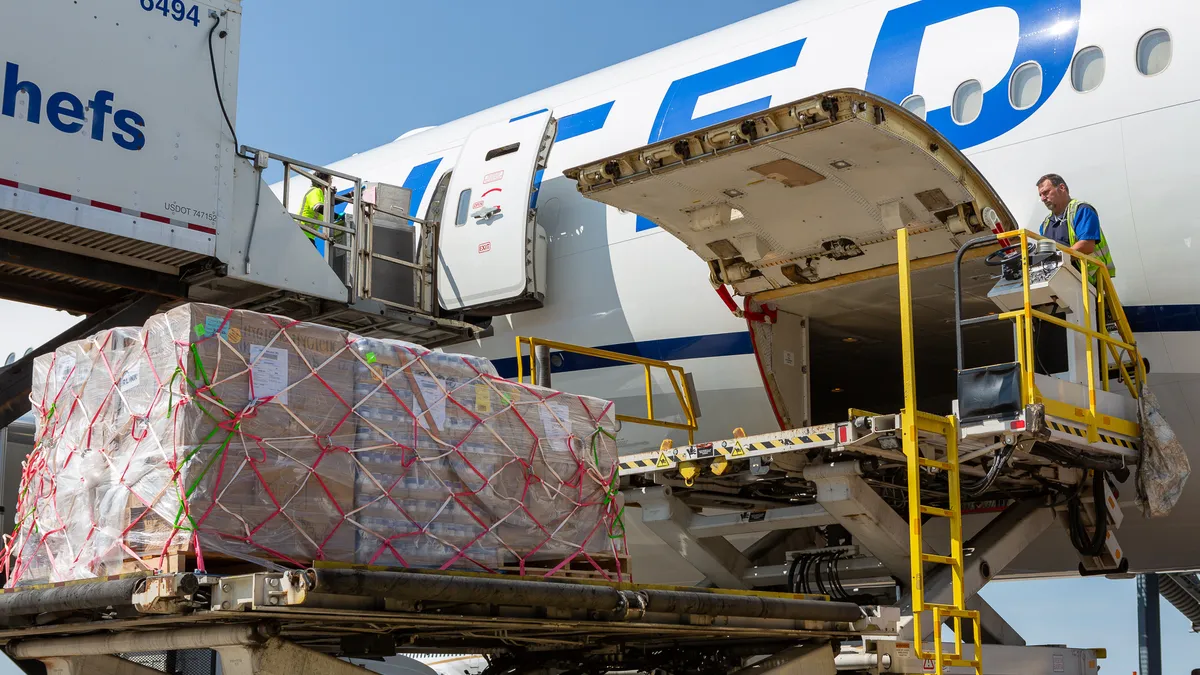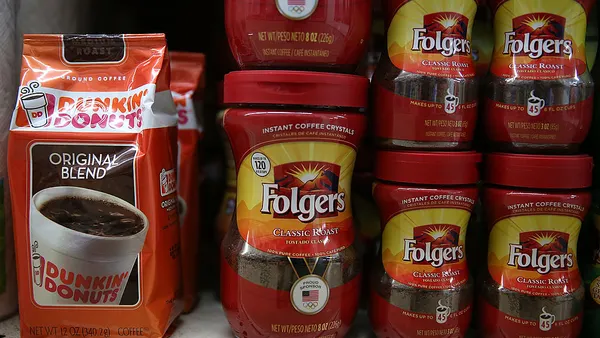How an expanded US footprint would add resilience to TSMC's supply chain

This story is part of a Supply Chain Dive series on reshoring supply chains.
It wasn't the Grand Canyon nor the abundant turquoise jewelry that brought the Taiwan Semiconductor Manufacturing Company, one of the largest players in the semiconductor industry, to announce in mid-May its intention to build a factory in Arizona.
"They chose Arizona for our unbeatable business climate, already thriving tech sector and ready access to an international supply chain," Gov. Doug Ducey said in a statement in May.
By adding an Arizona facility to its existing manufacturing footprint — an intention that has been announced but not finalized — the company would be close to a number of existing and potential buyers of the semiconductor products it manufactures. This would include Intel Corporation, ON Semiconductor, NXP Semiconductors, Microchip Technology, and others, according to the Greater Phoenix Economic Council (GPEC).
TSMC is based, as its name implies, in Taiwan, so a move to North America is far shoring rather than nearshoring. But a move into the United States would add resiliency to the technology supply chain and act as a form of nearshoring for the companies that rely on TSMC products, experts told Supply Chain Dive.
TSMC's existing manufacturing footprint
| Facility count | Product | Country; Subsidiary (if not TSMC) |
|---|---|---|
| 3 | 12-inch wafer GIGAFAB fab | Taiwan |
| 4 | 8-inch wafer fab | Taiwan |
| 1 | 6-inch wafer fab | Taiwan |
| 1 | 12-inch wafer fab | China; TSMC Nanjing Company Limited |
| 1 | 8-inch wafer fab | China; TSMC China Company Limited |
| 1 | 8-inch wafer fab | United States; WaferTech |
TSMC, along with its subsidiaries, employs 51,000 people globally. The Taiwanese company says it manufactures 10,000 different products for more than 480 customers.
TSMC said its Arizona facility would create 1,600 jobs and that it would spend $12 billion to build the facility over eight years starting in 2021. "This project is of critical, strategic importance to a vibrant and competitive U.S. semiconductor ecosystem that enables leading U.S. companies to fabricate their cutting-edge semiconductor products within the United States and benefit from the proximity of a world-class semiconductor foundry and ecosystem," TSMC said in a press release announcing its intention.
Factors at play in an operations move
Downstream buyers
One important consideration that makes the move possible for TSMC is who will buy its products. The factory TSMC plans to build is for wafer fabrication, which is the first step for building semiconductors. Semiconductor companies like Intel and Qualcomm are located in Arizona or neighboring states, according to Sangho Chae, an assistant professor of Supply Chain Management at Tilburg University in The Netherlands.
"By locating a wafer facility close to those big buyers, TSMC is trying to serve its customers better," Chae told Supply Chain Dive, adding the geographic proximity would allow for more collaboration on planning and more just-in-time manufacturing.
Buyer-supplier collaboration is currently possible at long distances thanks to modern-day technology, but it can be difficult to execute just-in-time practices when supplier and buyers are so far apart, Chae said.
The wafer manufacturing process can involve hundreds of unit operations and can have a cycle time of between 10 and 15 weeks, according to a 2017 paper of semiconductor supply chains published in the International Journal of Production Research.
If it hadn't been for [COVID-19] that would not have happened.
"Layers of material with different electrical characteristics are built up on a raw wafer, usually of silicon but sometimes of another semiconductor material such as gallium arsenide or indium phosphide," reads the paper describing the wafer fabrication process. The paper was written by Lars Mönch; a professor at the University of Hagen; Reha Uzsoy from North Carolina State University; and John Fowler from Arizona State University.
A 2016 report from the GPEC found that companies throughout the semiconductor supply chain in the region "indicate a strong preference for purchasing from other local companies."
Being close to a talent pool and its customers were two reasons TSMC provided for the move to Arizona in a statement to Supply Chain Dive, saying it "not only enables us to better support our customers and partners, it also gives us more opportunities to attract outstanding global talent to the Company and the semiconductor industry. We also expect to expand our business in the United States."
Labor
Access to this talent is important due to what TSMC is producing, Chae said.
"The semiconductor industry is capital intensive rather than being labor-intensive so labor cost is not a key factor in ... location decisions," Chae said.
The industry instead relies on highly skilled labor, which the Arizona university system and neighboring states could provide.
Rather than dealing with this uncertainty, TSMC and its U.S. buyers, they may have decided to locate the facility where they don't have to worry about tariffs.
The "technological complexity of both products and processes requires skilled engineers, technicians, and scientists to design new products and processes and troubleshoot existing ones," Mönch wrote in his paper. "The need to maintain this highly skilled workforce even during industry downturns imposes substantial fixed costs."
Geopolitics
"You've got the tension between Taiwan, China and [the U.S.] about Taiwan's independence and Hong Kong," according to Harry Moser, the founder of the Reshoring Initiative. "All this stuff's in that pot getting mixed up ... so there's probably some geopolitics there."
The Trump administration's ongoing trade war is likely another consideration for TSMC, according to Chae.
"So rather than dealing with this uncertainty, TSMC and its U.S. buyers, they may have decided to locate the facility where they don't have to worry about tariffs," Chae said.
Two of TSMC's largest subsidiaries are based in China: Nanjing and Shanghai, according to the company's 2019 annual report.
TSMC is not the only technology company considering a move to the U.S. The Trump administration is talking with TSMC and Intel about moving operations to the U.S. to improve the security of electronics supply chains, according to The Wall Street Journal.
Seaborne import data from Panjiva shows shipments of semiconductor manufacturing equipment from suppliers shipped into the U.S. by Intel surged 25% year over year in the fourth quarter of 2019, but have fallen off nearly 46% year over year in the first four months of 2020. "That may reflect a mixture of capital investment disruptions due to COVID-19 as well as marking a pause in investment after" the fourth quarter uptick, according to a research note from Panjiva, the supply chain research unit of S&P Global Market Intelligence.
After surging in 2019, semiconductor imports fall in 2020
U.S. semiconductor imports, millions of dollars
Resilience
The pandemic has shown how supply chains can be disrupted when suppliers shut down. "Companies often reduce complexity in their supply chain after experiencing devastating major supply chain disruptions," Chae said.
The longer the supply chain, the more opportunity for disruption to occur. So TSMC is able to reduce its risk by cutting down on the miles between its factory and major buyers, he said.
"If it hadn't been for [COVID-19] that would not have happened," Moser said of TSMC's May announcement.
The Arizona project could also give the company sway with the Trump administration to get permission to continue selling its products to Huawei, one of its largest customers, Nicholas Lardy, a senior fellow at the Peterson Institute for International Economics, told the South China Morning Post.
TSMC is not the only technology supplier looking to make supply chain changes as a result of the pandemic. Wistron, an Apple supplier, said in March that half of its production capacity would be outside of China within a year — a process that began as a result of the trade war, but sped up due to the pandemic, according to Bloomberg.
Subsidies
TSMC said the move is being partially subsidized by the U.S. federal government and the state of Arizona.
"The U.S. state and federal governments have promised the subsidies to us, and to our suppliers, mainly because those high precision materials required in semiconductor fabs are not available in the U.S., so it is a good opportunity to expand in the U.S." TSMC Chairman Dr. Mark Liu said on June 9, according to a statement provided by the company. The "subsidy is a key for TSMC to go to the U.S. What we’ve asked is we hope the U.S. federal and state governments can make up TSMC’s running costs."
Subsidies alone would likely not be enough to get TSMC to move to Arizona, Chae said. Government funding or other benefits can help a company decide between two locations, but there needs to be more than just money and the proximity to buyers and universities act as that draw, he said.
"Issues such as access to a qualified workforce, infrastructure and tax incentives are major factors in practice, resulting in a relatively small number of alternative locations for new facilities," Mönch wrote. "Combined with the difficulty of quantifying the many uncertainties to which the industry is subject, this may render quantitative models of limited value."
When asked for details on how the project came together a spokesperson for the Arizona Commerce Authority declined to comment on what they called "an active economic development project," adding that more information "will be provided once all aspects of this project are finalized."
Have we been here before?
But this all does feel a bit like déjà vu: a major technology supplier from Taiwan promising to move across the Pacific to spend billions on a factory and generate thousands of jobs. That's because Foxconn made a similar announcement in the summer of 2017, pledging to bring 13,000 jobs to Wisconsin, according to the Milwaukee Journal Sentinel.
The grand promises from Foxconn were eventually scaled back significantly. The company did build some innovation centers in the state, but the locations are largely empty, according to The Verge. (Foxconn said this reporting had "a lot of inaccuracies," but didn't say what they were, according to The Verge.)
The calculus is different for TSMC, though, Chae said. Foxconn is an electronics manufacturing service provider, which is different than making the raw material for semiconductors.
"The industry that they are in is a bit more labor-intensive," he said, while the semiconductor industry is more capital intensive.
TSMC and the state of Arizona said there were still some details that need to be finalized — including the exact location of the factory. But TSMC said it expected to begin construction by 2021 and start production by 2024.
This story was updated with revised information from TSMC about government subsidies.













